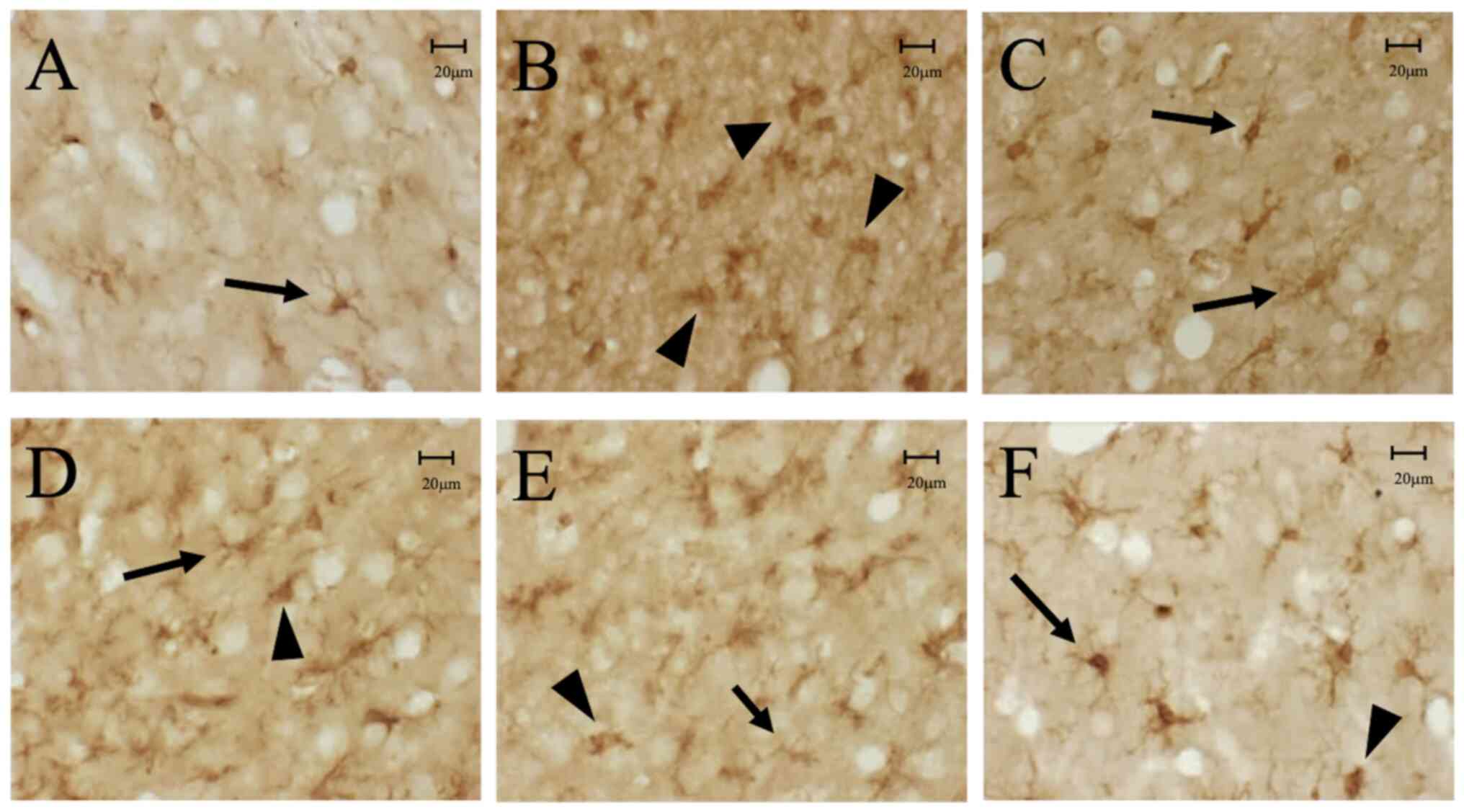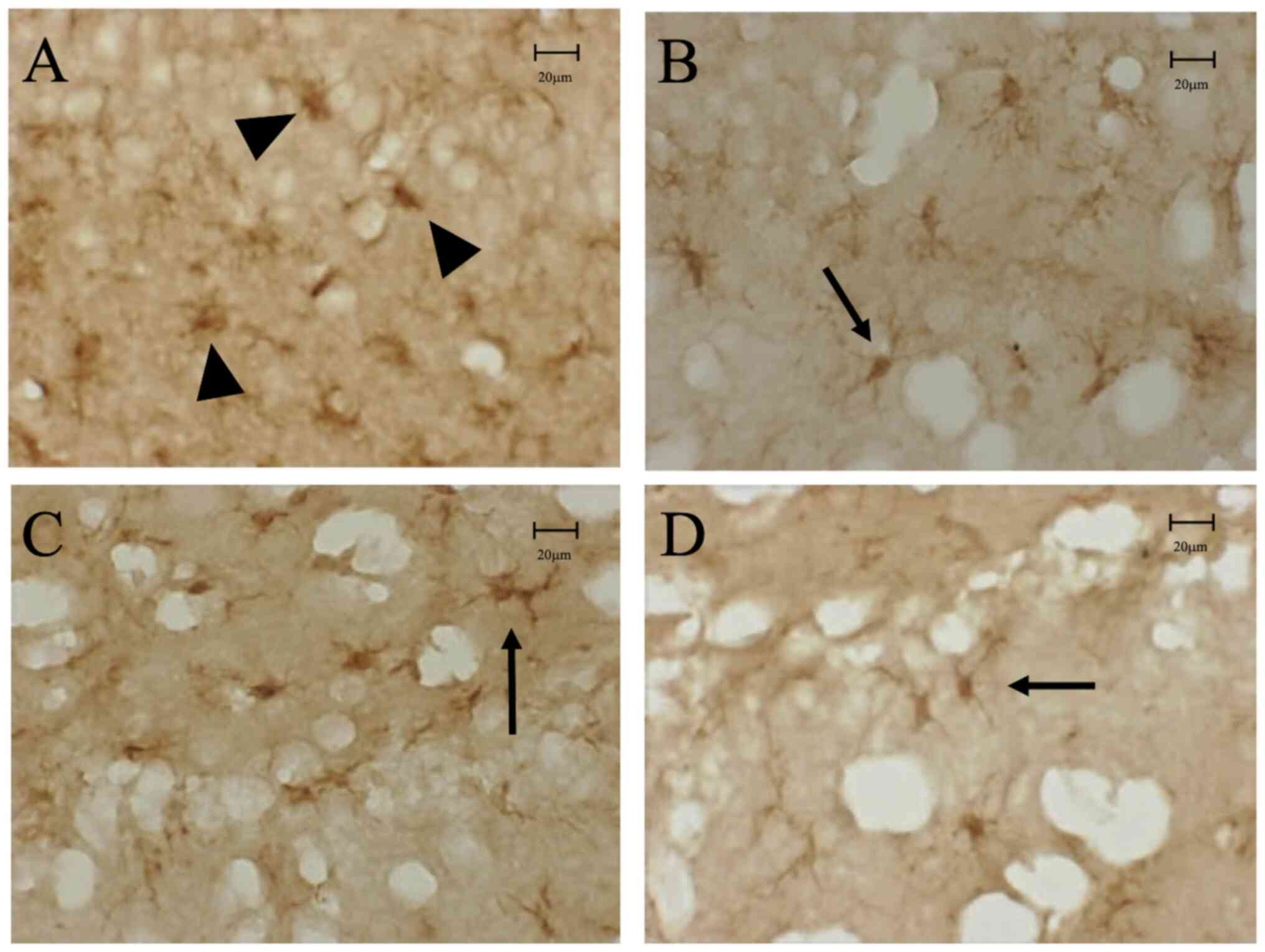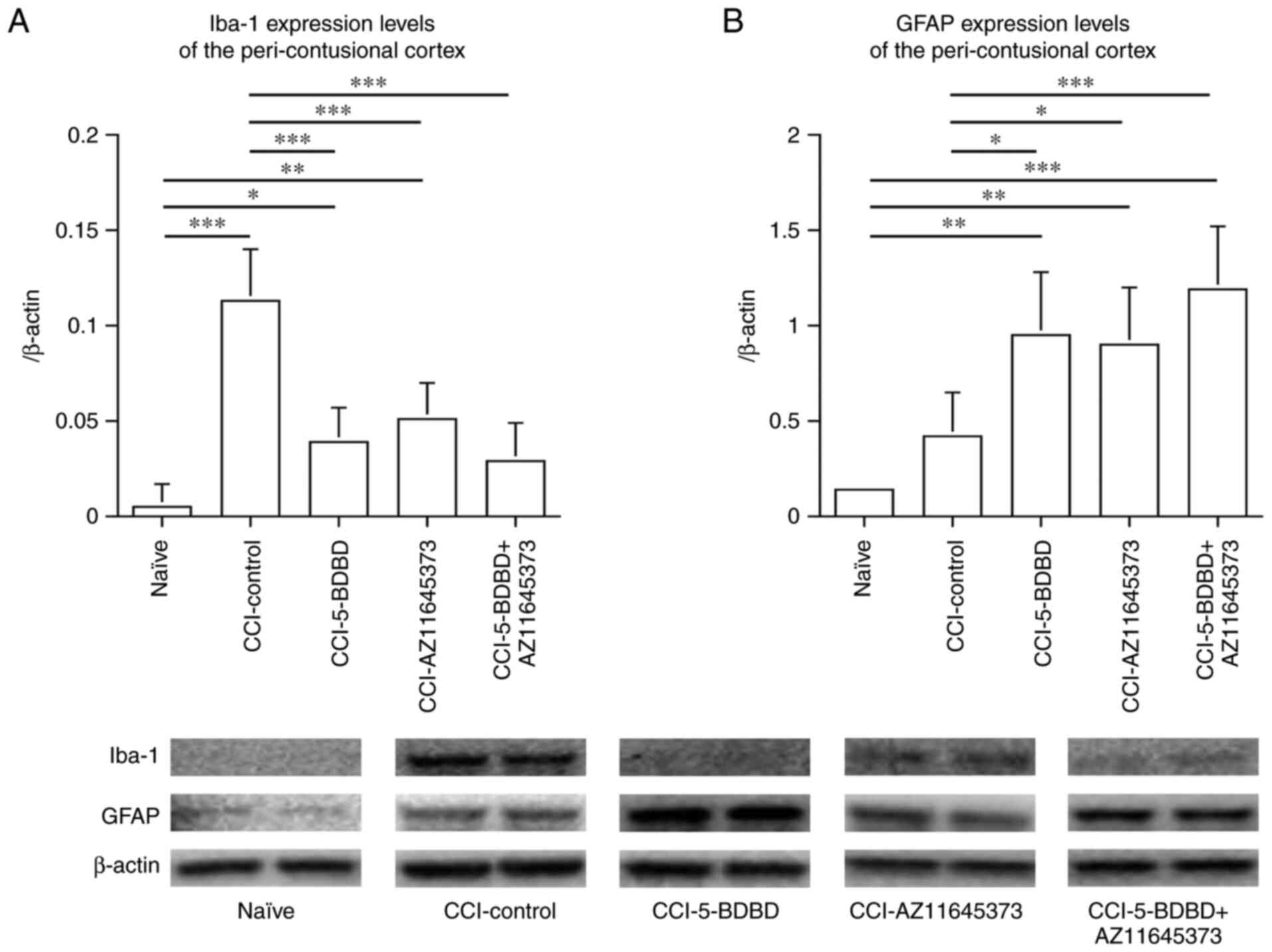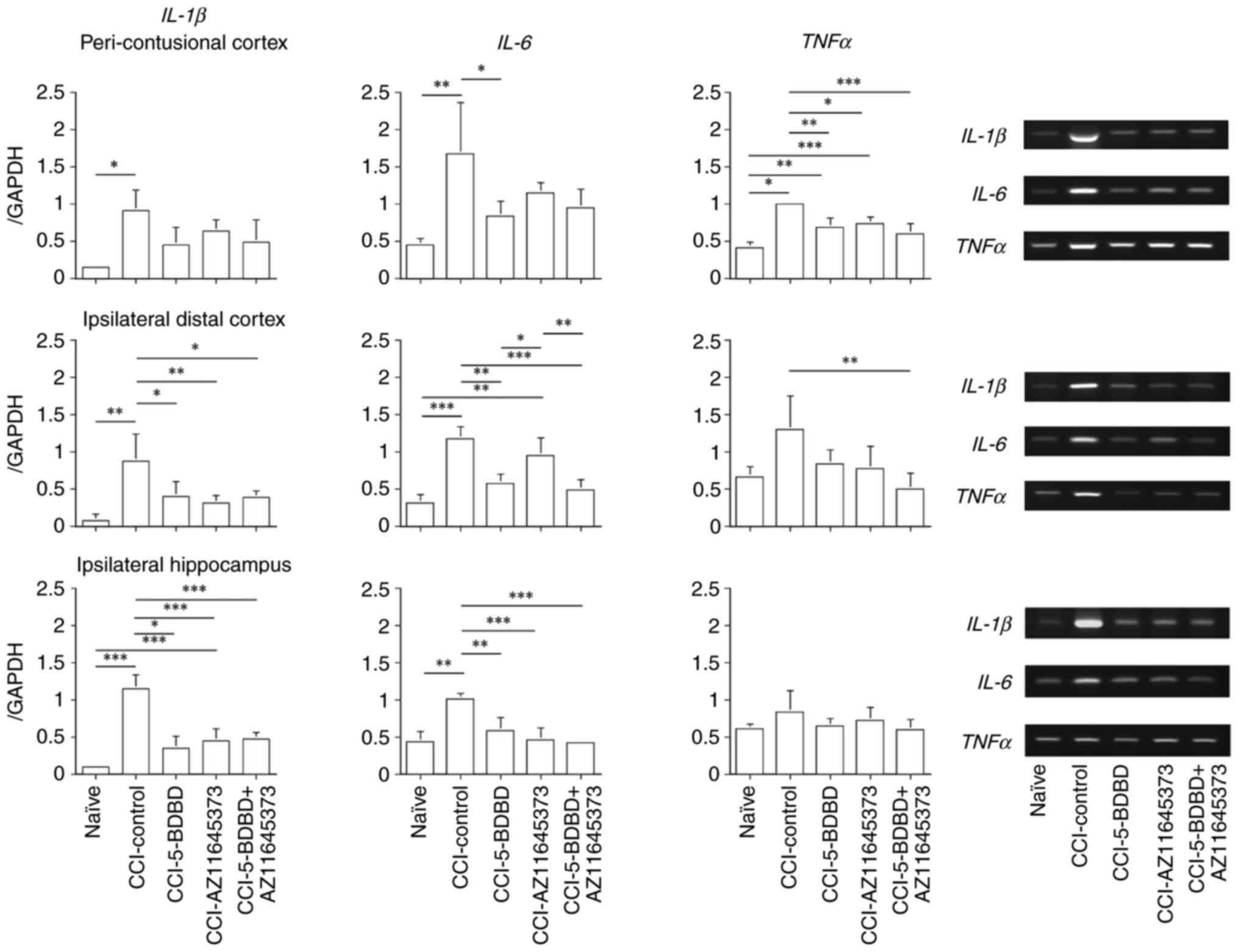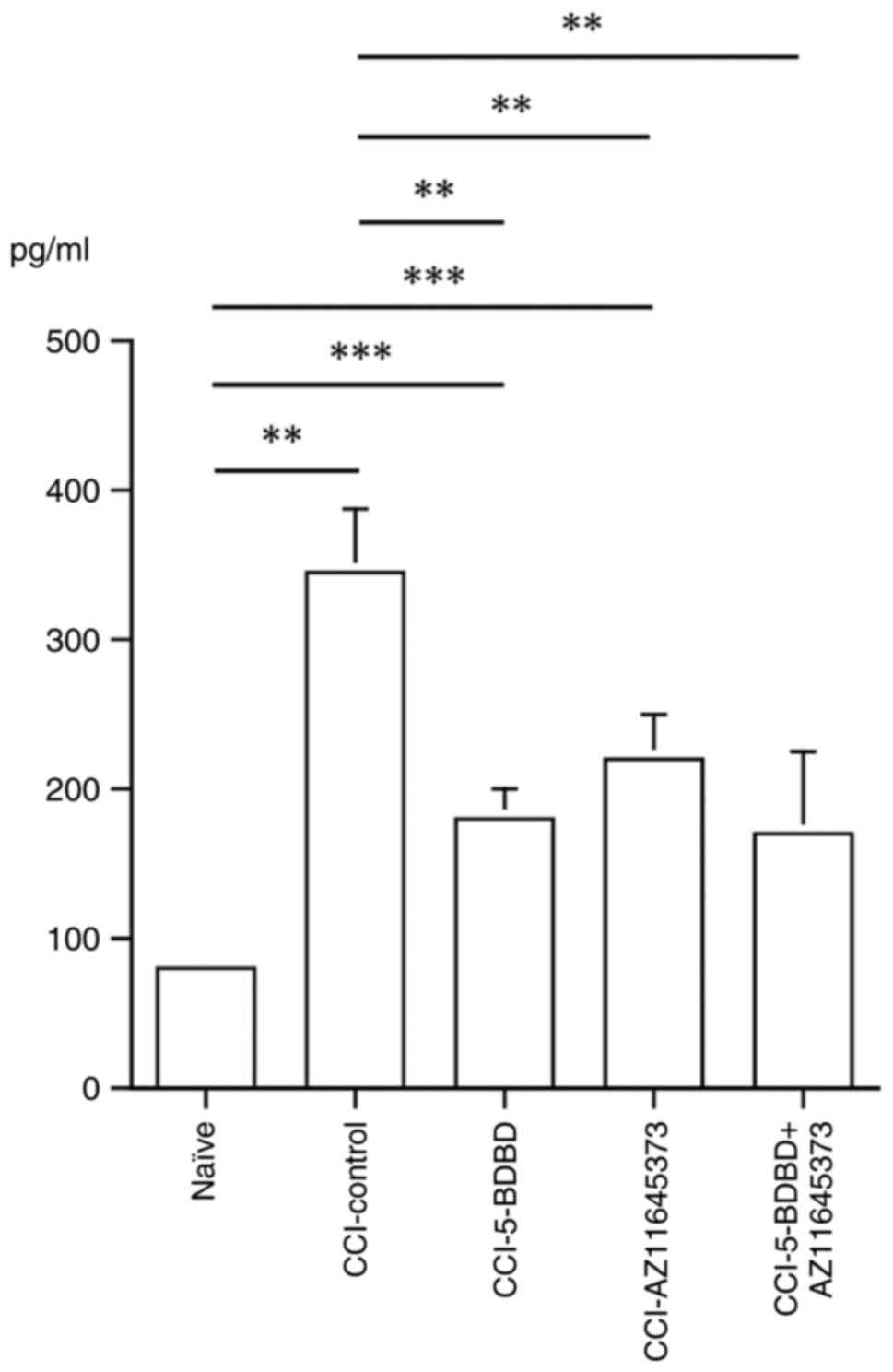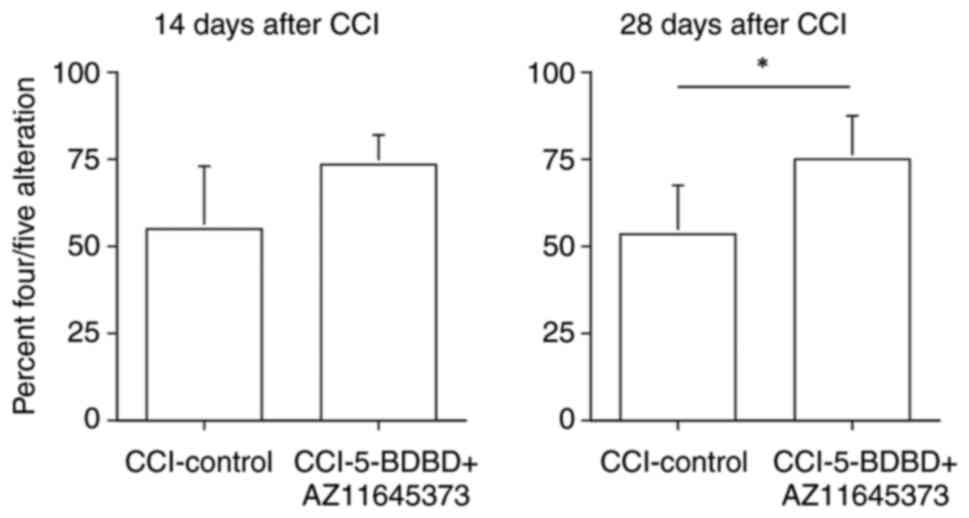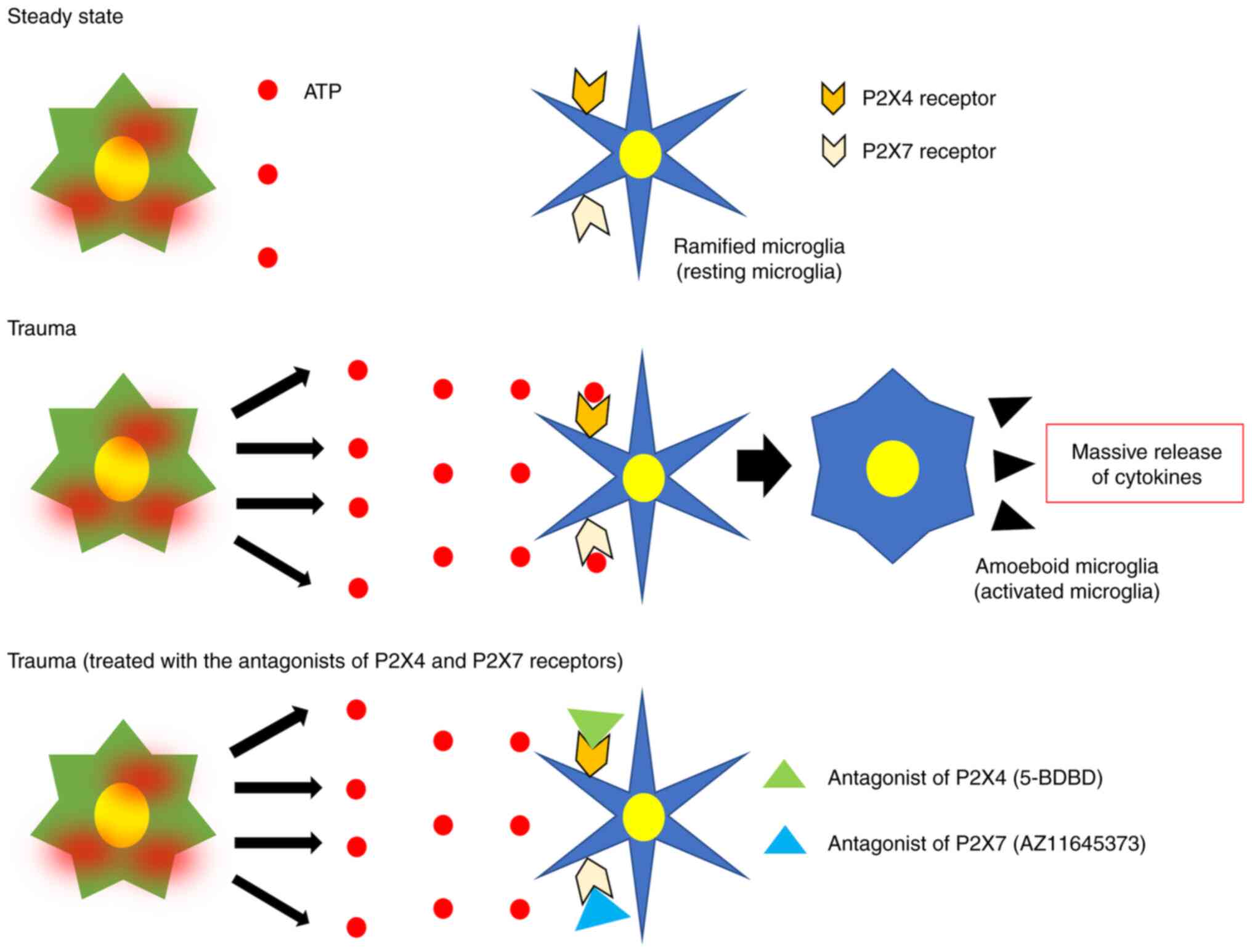|
1
|
Davalos D, Grutzendler J, Yang G, Kim JV,
Zuo Y, Jung S, Littman DR, Dustin ML and Gan WB: ATP mediates rapid
microglial response to local brain injury in vivo. Nat Neurosci.
8:752–758. 2005.PubMed/NCBI View
Article : Google Scholar
|
|
2
|
Koizumi S, Shigemoto-Mogami Y, Nasu-Tada
K, Shinozaki Y, Ohsawa K, Tsuda M, Joshi BV, Jacobson KA, Kohsaka S
and Inoue K: UDP acting at P2Y6 receptors is a mediator of
microglial phagocytosis. Nature. 446:1091–1095. 2007.PubMed/NCBI View Article : Google Scholar
|
|
3
|
Wyatt SK, Witt T, Barbaro NM, Cohen-Gadol
AA and Brewster AL: Enhanced classical complement pathway
activation and altered phagocytosis signaling molecules in human
epilepsy. Exp Neurol. 295:184–193. 2017.PubMed/NCBI View Article : Google Scholar
|
|
4
|
Haydon PG and Carmignoto G: Astrocyte
control of synaptic transmission and neurovascular coupling.
Physiol Rev. 86:1009–1031. 2006.PubMed/NCBI View Article : Google Scholar
|
|
5
|
Cornell-Bell AH, Finkbeiner SM, Cooper MS
and Smith SJ: Glutamate induces calcium waves in cultured
astrocytes: Long-range glial signaling. Science. 247:470–473.
1990.PubMed/NCBI View Article : Google Scholar
|
|
6
|
Guthrie PB, Knappenberger J, Segal M,
Bennett MV, Charles AC and Kater SB: ATP released from astrocytes
mediates glial calcium waves. J Neurosci. 19:520–528.
1999.PubMed/NCBI View Article : Google Scholar
|
|
7
|
Taib T, Leconte C, Van Steenwinckel J, Cho
AH, Palmier B, Torsello E, Lai Kuen R, Onyeomah S, Ecomard K,
Benedetto C, et al: Neuroinflammation, myelin and behavior:
Temporal patterns following mild traumatic brain injury in mice.
PLoS One. 12(e0184811)2017.PubMed/NCBI View Article : Google Scholar
|
|
8
|
Miller WJ, Leventhal I, Scarsella D,
Haydon PG, Janmey P and Meaney DF: Mechanically induced reactive
gliosis causes ATP-mediated alterations in astrocyte stiffness. J
Neurotrauma. 26:789–797. 2009.PubMed/NCBI View Article : Google Scholar
|
|
9
|
Moro N, Ghavim SS and Sutton RL: Massive
efflux of adenosine triphosphate into the extracellular space
immediately after experimental traumatic brain injury. Exp Ther
Med. 21(575)2021.PubMed/NCBI View Article : Google Scholar
|
|
10
|
Hua Y, Schallert T, Keep RF, Wu J, Hoff JT
and Xi G: Behavioral tests after intracerebral hemorrhage in the
rat. Stroke. 33:2478–2484. 2002.PubMed/NCBI View Article : Google Scholar
|
|
11
|
Thelin EP, Frostell A, Mulder J, Mitsios
N, Damberg P, Aski SN, Risling M, Svensson M, Morganti-Kossmann MC
and Bellander BM: Lesion size is exacerbated in hypoxic rats
whereas hypoxia-inducible factor-1 alpha and vascular endothelial
growth factor increase in injured normoxic rats: A prospective
cohort study of secondary hypoxia in focal traumatic brain injury.
Front Neurol. 7(23)2016.PubMed/NCBI View Article : Google Scholar
|
|
12
|
Xu L, He D and Bai Y: Microglia-mediated
inflammation and neurodegenerative disease. Mol Neurobiol.
53:6709–6715. 2016.PubMed/NCBI View Article : Google Scholar
|
|
13
|
Delekate A, Füchtemeier M, Schumacher T,
Ulbrich C, Foddis M and Petzold GC: Metabotropic P2Y1 receptor
signalling mediates astrocytic hyperactivity in vivo in an
Alzheimer's disease mouse model. Nat Commun. 5(5422)2014.PubMed/NCBI View Article : Google Scholar
|
|
14
|
Choo AM, Miller WJ, Chen YC, Nibley P,
Patel TP, Goletiani C, Morrison B III, Kutzing MK, Firestein BL,
Sul JY, et al: Antagonism of purinergic signalling improves
recovery from traumatic brain injury. Brain. 136:65–80.
2013.PubMed/NCBI View Article : Google Scholar
|
|
15
|
Kumagawa T, Moro N, Maeda T, Kobayashi M,
Furukawa Y, Shijo K and Yoshino A: Anti-inflammatory effect of P2Y1
receptor blocker MRS2179 in a rat model of traumatic brain injury.
Brain Res Bull. 181:46–54. 2022.PubMed/NCBI View Article : Google Scholar
|
|
16
|
Filiano AJ, Gadani SP and Kipnis J:
Interactions of innate and adaptive immunity in brain development
and function. Brain Res. 1617:18–27. 2015.PubMed/NCBI View Article : Google Scholar
|
|
17
|
Sordillo PP, Sordillo LA and Helson L:
Bifunctional role of pro-inflammatory cytokines after traumatic
brain injury. Brain Inj. 30:1043–1053. 2016.PubMed/NCBI View Article : Google Scholar
|
|
18
|
Moro N, Ghavim SS, Harris NG, Hovda DA and
Sutton RL: Pyruvate treatment attenuates cerebral metabolic
depression and neuronal loss after experimental traumatic brain
injury. Brain Res. 1642:270–277. 2016.PubMed/NCBI View Article : Google Scholar
|
|
19
|
Goodman JC, Cherian L, Bryan RM Jr and
Robertson CS: Lateral cortical impact injury in rats: Pathologic
effects of varying cortical compression and impact velocity. J
Neurotrauma. 11:587–597. 1994.PubMed/NCBI View Article : Google Scholar
|
|
20
|
Dalgard CL, Cole JT, Kean WS, Lucky JJ,
Sukumar G, McMullen DC, Pollard HB and Watson WD: The cytokine
temporal profile in rat cortex after controlled cortical impact.
Front Mol Neurosci. 5(6)2012.PubMed/NCBI View Article : Google Scholar
|
|
21
|
Sofroniew MV and Vinters HV: Astrocytes:
Biology and pathology. Acta Neuropathol. 119:7–35. 2010.PubMed/NCBI View Article : Google Scholar
|
|
22
|
Zhang L, Schallert T, Zhang ZG, Jiang Q,
Arniego P, Li Q, Lu M and Chopp M: A test for detecting long-term
sensorimotor dysfunction in the mouse after focal cerebral
ischemia. J Neurosci Methods. 117:207–214. 2002.PubMed/NCBI View Article : Google Scholar
|
|
23
|
Gharbawie OA, Whishaw PA and Whishaw IQ:
The topography of three-dimensional exploration: A new
quantification of vertical and horizontal exploration, postural
support, and exploratory bouts in the cylinder test. Behav Brain
Res. 151:125–135. 2004.PubMed/NCBI View Article : Google Scholar
|
|
24
|
Chao OY, Pum ME, Li JS and Huston JP: The
grid-walking test: Assessment of sensorimotor deficits after
moderate or severe dopamine depletion by 6-hydroxydopamine lesions
in the dorsal striatum and medial forebrain bundle. Neuroscience.
202:318–325. 2012.PubMed/NCBI View Article : Google Scholar
|
|
25
|
McNay EC, Fries TM and Gold PE: Decreases
in rat extracellular hippocampal glucose concentration associated
with cognitive demand during a spatial task. Proc Natl Acad Sci
USA. 97:2881–2885. 2000.PubMed/NCBI View Article : Google Scholar
|
|
26
|
Taylor AN, Rahman SU, Sanders NC, Tio DL,
Prolo P and Sutton RL: Injury severity differentially affects
short- and long-term neuroendocrine outcomes of traumatic brain
injury. J Neurotrauma. 25:311–323. 2008.PubMed/NCBI View Article : Google Scholar
|
|
27
|
Tan J, Town T, Paris D, Mori T, Suo Z,
Crawford F, Mattson MP, Flavell RA and Mullan M: Microglial
activation resulting from CD40-CD40L interaction after beta-amyloid
stimulation. Science. 286:2352–2355. 1999.PubMed/NCBI View Article : Google Scholar
|
|
28
|
Faroqi AH, Lim MJ, Kee EC, Lee JH, Burgess
JD, Chen R, Di Virgilio F, Delenclos M and McLean PJ: In vivo
detection of extracellular adenosine triphosphate in a mouse model
of traumatic brain injury. J Neurotrauma. 38:655–664.
2021.PubMed/NCBI View Article : Google Scholar
|
|
29
|
Melani A, Turchi D, Vannucchi MG, Cipriani
S, Gianfriddo M and Pedata F: ATP extracellular concentrations are
increased in the rat striatum during in vivo ischemia. Neurochem
Int. 47:442–448. 2005.PubMed/NCBI View Article : Google Scholar
|
|
30
|
Peng J, Liu Y, Umpierre AD, Xie M, Tian
DS, Richardson JR and Wu LJ: Microglial P2Y12 receptor regulates
ventral hippocampal CA1 neuronal excitability and innate fear in
mice. Mol Brain. 12(71)2019.PubMed/NCBI View Article : Google Scholar
|
|
31
|
Abiega O, Beccari S, Diaz-Aparicio I,
Nadjar A, Layé S, Leyrolle Q, Gómez-Nicola D, Domercq M,
Pérez-Samartín A, Sánchez-Zafra V, et al: Neuronal hyperactivity
disturbs ATP microgradients, impairs microglial motility, and
reduces phagocytic receptor expression triggering
apoptosis/microglial phagocytosis uncoupling. PLoS Biol.
14(e1002466)2016.PubMed/NCBI View Article : Google Scholar
|
|
32
|
Trapp BD, Bö L, Mörk S and Chang A:
Pathogenesis of tissue injury in MS lesions. J Neuroimmunol.
98:49–56. 1999.PubMed/NCBI View Article : Google Scholar
|
|
33
|
Aboud O, Mrak RE, Boop F and Griffin ST:
Apolipoprotein epsilon 3 alleles are associated with indicators of
neuronal resilience. BMC Med. 10(35)2012.PubMed/NCBI View Article : Google Scholar
|
|
34
|
Osipova ED, Semyachkina-Glushkovskaya OV,
Morgun AV, Pisareva NV, Malinovskaya NA, Boitsova EB, Pozhilenkova
EA, Belova OA, Salmin VV, Taranushenko TE, et al: Gliotransmitters
and cytokines in the control of blood-brain barrier permeability.
Rev Neurosci. 29:567–591. 2018.PubMed/NCBI View Article : Google Scholar
|
|
35
|
Perez-Polo JR, Rea HC, Johnson KM, Parsley
MA, Unabia GC, Xu GY, Prough D, DeWitt DS, Paulucci-Holthauzen AA,
Werrbach-Perez K and Hulsebosch CE: Inflammatory cytokine receptor
blockade in a rodent model of mild traumatic brain injury. J
Neurosci Res. 94:27–38. 2016.PubMed/NCBI View Article : Google Scholar
|
|
36
|
Jassam YN, Izzy S, Whalen M, McGavern DB
and El Khoury J: Neuroimmunology of traumatic brain injury: Time
for a paradigm shift. Neuron. 95:1246–1265. 2017.PubMed/NCBI View Article : Google Scholar
|
|
37
|
Xu H, Wang Z, Li J, Wu H, Peng Y, Fan L,
Chen J, Gu C, Yan F, Wang L and Chen G: The polarization states of
microglia in TBI: A new paradigm for pharmacological intervention.
Neural Plast. 2017(5405104)2017.PubMed/NCBI View Article : Google Scholar
|
|
38
|
Menzel L, Kleber L, Friedrich C, Hummel R,
Dangel L, Winter J, Schmitz K, Tegeder I and Schäfer MK:
Progranulin protects against exaggerated axonal injury and
astrogliosis following traumatic brain injury. Glia. 65:278–292.
2017.PubMed/NCBI View Article : Google Scholar
|
|
39
|
Nikolic L, Shen W, Nobili P, Virenque A,
Ulmann L and Audinat E: Blocking TNFα-driven astrocyte purinergic
signaling restores normal synaptic activity during epileptogenesis.
Glia. 66:2673–2683. 2018.PubMed/NCBI View Article : Google Scholar
|
|
40
|
Silver J and Miller JH: Regeneration
beyond the glial scar. Nat Rev Neurosci. 5:146–156. 2004.PubMed/NCBI View Article : Google Scholar
|
|
41
|
Kaiser M, Penk A, Franke H, Krügel U,
Nörenberg W, Huster D and Schaefer M: Lack of functional P2X7
receptor aggravates brain edema development after middle cerebral
artery occlusion. Purinergic Signal. 12:453–463. 2016.PubMed/NCBI View Article : Google Scholar
|
|
42
|
Ekmark-Lewén S, Flygt J, Fridgeirsdottir
GA, Kiwanuka O, Hånell A, Meyerson BJ, Mir AK, Gram H, Lewén A,
Clausen F, et al: Diffuse traumatic axonal injury in mice induces
complex behavioural alterations that are normalized by
neutralization of interleukin-1β. Eur J Neurosci. 43:1016–1033.
2016.PubMed/NCBI View Article : Google Scholar
|
|
43
|
Helmy A, Guilfoyle MR, Carpenter KLH,
Pickard JD, Menon DK and Hutchinson PJ: Recombinant human
interleukin-1 receptor antagonist promotes M1 microglia biased
cytokines and chemokines following human traumatic brain injury. J
Cereb Blood Flow Metab. 36:1434–1448. 2016.PubMed/NCBI View Article : Google Scholar
|
|
44
|
Fehily B and Fitzgerald M: Repeated mild
traumatic brain injury: Potential mechanisms of damage. Cell
Transplant. 26:1131–1155. 2017.PubMed/NCBI View Article : Google Scholar
|
|
45
|
Shih AY, Johnson DA, Wong G, Kraft AD,
Jiang L, Erb H, Johnson JA and Murphy TH: Coordinate regulation of
glutathione biosynthesis and release by Nrf2-expressing glia
potently protects neurons from oxidative stress. J Neurosci.
23:3394–3406. 2003.PubMed/NCBI View Article : Google Scholar
|
|
46
|
Bush TG, Puvanachandra N, Horner CH,
Polito A, Ostenfeld T, Svendsen CN, Mucke L, Johnson MH and
Sofroniew MV: Leukocyte infiltration, neuronal degeneration, and
neurite outgrowth after ablation of scar-forming, reactive
astrocytes in adult transgenic mice. Neuron. 23:297–308.
1999.PubMed/NCBI View Article : Google Scholar
|
|
47
|
Rothstein JD, Dykes-Hoberg M, Pardo CA,
Bristol LA, Jin L, Kuncl RW, Kanai Y, Hediger MA, Wang Y, Schielke
JP and Welty DF: Knockout of glutamate transporters reveals a major
role for astroglial transport in excitotoxicity and clearance of
glutamate. Neuron. 16:675–686. 1996.PubMed/NCBI View Article : Google Scholar
|
|
48
|
Li L, Lundkvist A, Andersson D,
Wilhelmsson U, Nagai N, Pardo AC, Nodin C, Ståhlberg A, Aprico K,
Larsson K, et al: Protective role of reactive astrocytes in brain
ischemia. J Cereb Blood Flow Metab. 28:468–481. 2008.PubMed/NCBI View Article : Google Scholar
|
|
49
|
Okada S, Nakamura M, Katoh H, Miyao T,
Shimazaki T, Ishii K, Yamane J, Yoshimura A, Iwamoto Y, Toyama Y
and Okano H: Conditional ablation of Stat3 or Socs3 discloses a
dual role for reactive astrocytes after spinal cord injury. Nat
Med. 12:829–834. 2006.PubMed/NCBI View
Article : Google Scholar
|
|
50
|
Voskuhl RR, Peterson RS, Song B, Ao Y,
Morales LB, Tiwari-Woodruff S and Sofroniew MV: Reactive astrocytes
form scar-like perivascular barriers to leukocytes during adaptive
immune inflammation of the CNS. J Neurosci. 29:11511–11522.
2009.PubMed/NCBI View Article : Google Scholar
|
|
51
|
Oberheim NA, Tian GF, Han X, Peng W,
Takano T, Ransom B and Nedergaard M: Loss of astrocytic domain
organization in the epileptic brain. J Neurosci. 28:3264–3276.
2008.PubMed/NCBI View Article : Google Scholar
|
|
52
|
Norden DM, Trojanowski PJ, Villanueva E,
Navarro E and Godbout JP: Sequential activation of microglia and
astrocyte cytokine expression precedes increased Iba-1 or GFAP
immunoreactivity following systemic immune challenge. Glia.
64:300–316. 2016.PubMed/NCBI View Article : Google Scholar
|
|
53
|
Scherbel U, Raghupathi R, Nakamura M,
Saatman KE, Trojanowski JQ, Neugebauer E, Marino MW and McIntosh
TK: Differential acute and chronic responses of tumor necrosis
factor-deficient mice to experimental brain injury. Proc Natl Acad
Sci USA. 96:8721–8726. 1999.PubMed/NCBI View Article : Google Scholar
|















